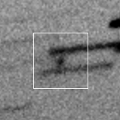
|
It brightened very rapidly. Now it is 11.0 mag (Aug. 18, Ken-ichi Kadota). It will brighten up to 8.5 mag from September to October. But the condition is bad in this apparition. In the Southern Hemisphere, it stays observable after this while the comet will be fading. But it stays locating low. It is not observable after this in the Northern Hemisphere.
Date(TT) R.A. (2000) Decl. Delta r Elong. m1 Best Time(A, h)
Aug. 28 8 42.81 5 25.4 1.835 1.026 25 9.1 4:00 (263, 0)
Sept. 4 9 5.34 -0 13.0 1.816 1.032 27 8.8 4:07 (269, -1)
|
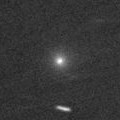
|
It was observed at 9-10 mag from late July to early August. Now it is not observable. It will appear in the morning sky in December, but it will be fainter than 15 mag at that time.
Date(TT) R.A. (2000) Decl. Delta r Elong. m1 Best Time(A, h)
Aug. 28 10 28.21 22 43.9 1.786 0.833 12 9.5 20:00 (125, -9)
Sept. 4 11 3.47 18 48.0 1.848 0.885 11 9.8 19:49 (119, -8)
|
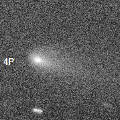
|
Now it is 11.3 mag (Aug. 18, Osamu Miyazaki). It stays observable at 10-11 mag in excellent condition from summer to autumn.
Date(TT) R.A. (2000) Decl. Delta r Elong. m1 Best Time(A, h)
Aug. 28 4 39.22 18 55.6 1.386 1.623 83 10.6 4:00 (290, 56)
Sept. 4 4 57.98 18 42.2 1.338 1.620 86 10.5 4:07 (294, 59)
|
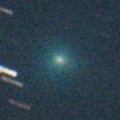
|
It brightened very rapidly. Now it is very bright as 11.1 mag (Aug. 6, Carlos Labordena). It will be fading after this. It stays observable in the morning sky for a long time.
Date(TT) R.A. (2000) Decl. Delta r Elong. m1 Best Time(A, h)
Aug. 28 6 39.56 26 50.4 1.408 1.186 55 10.8 4:00 (260, 36)
Sept. 4 7 1.22 26 58.1 1.437 1.241 57 11.2 4:07 (261, 38)
|
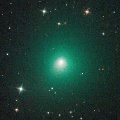
|
Now it is very bright as 10.9 mag (Aug. 13, Chris Wyatt). It will be fading after this. In the Northern Hemisphere, it will be getting lower gradually in the evening. In the Southern Hemisphere, it stays observable in good condition for a while.
Date(TT) R.A. (2000) Decl. Delta r Elong. m1 Best Time(A, h)
Aug. 28 15 10.61 -14 9.6 2.167 2.132 74 10.9 20:00 ( 52, 22)
Sept. 4 15 23.39 -16 29.6 2.256 2.156 71 11.1 19:49 ( 51, 20)
|
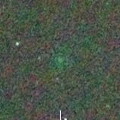
|
It brightened up to 4 mag in major outburst in 2016. In this apparition, it brightened up to 10.5 mag in early August (Aug. 8, Rob Kaufman). Now it is 12.8 mag (Aug. 18, Ken-ichi Kadota). In the Southern Hemisphere, it stays locating low in the evening sky until October. In the Northern Hemisphere, it stays locating extremely low.
Date(TT) R.A. (2000) Decl. Delta r Elong. m1 Best Time(A, h)
Aug. 28 13 0.61 -1 52.9 1.777 1.199 40 11.2 20:00 ( 83, 6)
Sept. 4 13 28.10 -4 0.7 1.829 1.251 40 11.6 19:49 ( 80, 7)
|
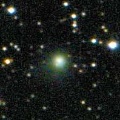
|
Now it is 11.6 mag (Aug. 18, Osamu Miyazaki). It will brighten up to 10 mag in winter in 2022. In the Northern Hemisphere, it stays observable in good condition for a long time. In the Southern Hemisphere, it is not observable until November.
Date(TT) R.A. (2000) Decl. Delta r Elong. m1 Best Time(A, h)
Aug. 28 6 51.31 45 49.2 4.195 3.759 58 11.7 4:00 (236, 40)
Sept. 4 7 0.68 45 17.2 4.098 3.739 62 11.6 4:07 (238, 44)
|
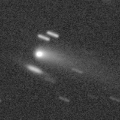
|
Now it is 12.7 mag (Aug. 25, Ken-ichi Kadota). It will brighten up to 9 mag, and will be observable in good condition in winter.
Date(TT) R.A. (2000) Decl. Delta r Elong. m1 Best Time(A, h)
Aug. 28 2 50.20 12 3.0 0.750 1.457 110 12.3 4:00 (345, 66)
Sept. 4 3 12.94 13 59.2 0.684 1.413 111 11.9 4:07 (351, 69)
|
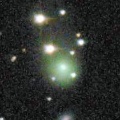
|
Now it is 12.5 mag (Aug. 18, Ken-ichi Kadota). It is expected to be observable at 5-6 mag for a long time from 2022 to 2023. In the Northern Hemisphere, it is not observable at the high light from 2022 autumn to 2023 summer. In the Southern Hemisphere, it stays low for a while. But it will be observable in good condition at the high light.
Date(TT) R.A. (2000) Decl. Delta r Elong. m1 Best Time(A, h)
Aug. 28 16 57.92 33 27.4 5.381 5.495 91 12.1 20:00 ( 91, 71)
Sept. 4 16 56.95 32 0.5 5.388 5.435 87 12.0 19:49 ( 90, 67)
|
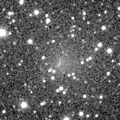
|
Now it is 12.8 mag (Aug. 7, Thomas Lehmann). It will brighten very rapidly, and it will be observable at 10 mag in good condition from October to December. In the Northern Hemisphere, it locates somewhat low at the high light.
Date(TT) R.A. (2000) Decl. Delta r Elong. m1 Best Time(A, h)
Aug. 28 17 0.24 -11 54.4 0.771 1.376 100 12.5 20:00 ( 27, 39)
Sept. 4 17 17.26 -15 40.2 0.786 1.364 98 12.0 19:49 ( 25, 35)
|
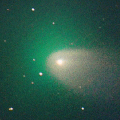
|
It brightened up to 9.7 mag in June (June 4, Michael Jager). Now it is fading. It has already faded down to 12.8 mag (Aug. 13, Chris Wyatt). In the Southern Hemisphere, it stays observable in excellent condition for a long time. In the Northern Hemisphere, it becomes extremely low after this.
Date(TT) R.A. (2000) Decl. Delta r Elong. m1 Best Time(A, h)
Aug. 28 23 50.64 -51 59.3 0.778 1.651 134 12.9 1:27 ( 0, 3)
Sept. 4 23 42.23 -51 54.3 0.838 1.702 134 13.2 0:51 ( 0, 3)
|
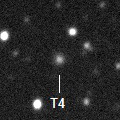
|
Now it is 14.6 mag (July 12, Chris Wyatt). It is expected to brighten up to 11.5 mag in 2022. In the Southern Hemisphere, it stas observable in good condition for a long time, although it becomes extremely low temporarily from August to September. In the Northern Hemisphere, it is not observable until November.
Date(TT) R.A. (2000) Decl. Delta r Elong. m1 Best Time(A, h)
Aug. 28 10 4.39 -22 35.0 5.667 4.849 32 13.6 4:00 (276,-33)
Sept. 4 10 12.32 -22 48.3 5.652 4.822 31 13.6 4:07 (280,-27)
|
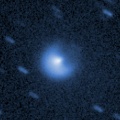
|
Outburst occured on Aug. 25. Now it is 14.4 mag (Aug. 26, Jean-Francois Soulier).
Date(TT) R.A. (2000) Decl. Delta r Elong. m1 Best Time(A, h)
Aug. 28 4 49.99 31 2.4 6.002 5.908 79 13.7 4:00 (267, 59)
Sept. 4 4 52.69 31 14.3 5.895 5.910 85 13.6 4:07 (271, 66)
|
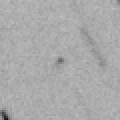
|
Now it is 16.0 mag (Aug. 17, Thomas Lehmann). It will brighten rapidly up to 9 mag in winter. It will be observable in good condition. In the Southern Hemisphere, it is observable in excellent condition. In the Northren Hemisphere, it is not observable until November.
Date(TT) R.A. (2000) Decl. Delta r Elong. m1 Best Time(A, h)
Aug. 28 0 13.23 -54 51.0 1.370 2.165 130 14.6 1:49 ( 0, 0)
Sept. 4 0 7.15 -56 27.4 1.330 2.112 128 14.2 1:16 ( 0, -1)
|

|
Now it is 14.5 mag (Aug. 10, Chris Wyatt). It stays 13-14 mag from 2020 to 2021. It will be observable in good condition after this in the Southern Hemisphere. It locates low in the Northern Hemisphere.
Date(TT) R.A. (2000) Decl. Delta r Elong. m1 Best Time(A, h)
Aug. 28 18 43.76 -35 35.7 2.355 3.032 123 14.3 20:17 ( 0, 19)
Sept. 4 18 45.30 -35 32.2 2.447 3.044 117 14.4 19:51 ( 0, 19)
|
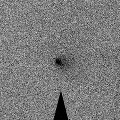
|
It brightened up to 10.1 mag in spring (Apr. 10, Marco Goiato). Now it is fading. It has already faded down to 14.8 mag (Aug. 10, Chris Wyatt). It stays observable in good condition for a long time after this while the comet will fading.
Date(TT) R.A. (2000) Decl. Delta r Elong. m1 Best Time(A, h)
Aug. 28 4 35.85 8 52.3 1.895 2.085 86 14.3 4:00 (303, 50)
Sept. 4 4 42.65 8 40.2 1.857 2.129 91 14.5 4:07 (312, 55)
|
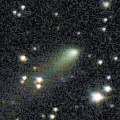
|
Now it is 14.0 mag (Aug. 18, Ken-ichi Kadota). It stays 14 mag until October, and it is observable in good condition. It locates somewhat low in the Southern Hemisphere.
Date(TT) R.A. (2000) Decl. Delta r Elong. m1 Best Time(A, h)
Aug. 28 16 49.80 27 30.4 2.074 2.318 90 14.4 20:00 ( 77, 68)
Sept. 4 16 36.99 25 53.2 2.192 2.308 83 14.5 19:49 ( 80, 61)
|
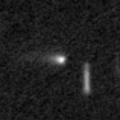
|
Now it is 16.2 mag (July 30, Thomas Lehmann). It will approach to Earth down to 0.2 a.u. in December, and it is expected to brighten up to 4 mag. In the Northern Hemisphere, it stays observable in good condition for a long time until December while the comet is brightening gradually, although it becomes extremely low temporarily in September. In the Southern Hemisphere, it is not observable until mid December.
Date(TT) R.A. (2000) Decl. Delta r Elong. m1 Best Time(A, h)
Aug. 28 10 51.46 41 58.9 3.124 2.337 32 14.7 20:00 (137, 8)
Sept. 4 10 56.48 41 0.8 3.009 2.241 33 14.4 19:49 (137, 6)
|

|
Now it is 13.9 mag (Aug. 18, Ken-ichi Kadota). It will be getting lower rapidly after this, and it will be unobservable in September.
Date(TT) R.A. (2000) Decl. Delta r Elong. m1 Best Time(A, h)
Aug. 28 13 42.94 -4 49.2 4.118 3.573 51 14.6 20:00 ( 75, 12)
Sept. 4 13 44.66 -4 21.3 4.240 3.595 44 14.7 19:49 ( 77, 10)
|
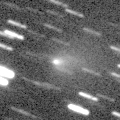
|
Outburst occured in early August. Now it is very bright as 14.6 mag (Aug. 18, Ken-ichi Kadota). In the Northern Hemisphere, it stays observable in good condition. In the Southern Hemipsphere, it stays locating extremely low after this.
Date(TT) R.A. (2000) Decl. Delta r Elong. m1 Best Time(A, h)
Aug. 28 5 9.92 41 35.5 2.574 2.515 75 14.6 4:00 (246, 57)
Sept. 4 5 20.50 42 22.4 2.520 2.542 79 14.7 4:07 (244, 62)
|
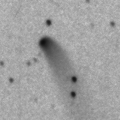
|
Now it is 14.4 mag (Aug. 10, Chris Wyatt). It stays 14-15 mag until the end of 2021. In the Southern Hemisphere, it stays observable in good condition for a long time. It locates low in the Northern Hemisphere.
Date(TT) R.A. (2000) Decl. Delta r Elong. m1 Best Time(A, h)
Aug. 28 23 6.59 -33 3.2 3.580 4.515 154 14.6 0:43 ( 0, 22)
Sept. 4 22 59.93 -32 34.3 3.600 4.532 154 14.6 0:09 ( 0, 23)
|
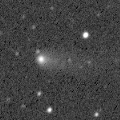
|
Now it is 15.0 mag (Aug. 13, Chris Wyatt). It was expected to brighten up to 13 mag from spring to summer. But actually, it is fainter than originally expected. It stays 14-15 mag until early autumn. In the Southern Hemisphere, it stays observable in good condition for a long time. In the Northern Hemisphere, it is not observable until July in 2022.
Date(TT) R.A. (2000) Decl. Delta r Elong. m1 Best Time(A, h)
Aug. 28 20 54.83 -86 19.5 3.280 3.645 103 14.9 22:31 ( 0,-31)
Sept. 4 20 42.84 -85 19.1 3.323 3.656 101 14.9 21:52 ( 0,-30)
|
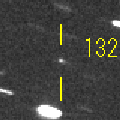
|
Now it is 17.1 mag (Aug. 17, Thomas Lehmann). It will brighten very rapidly up to 14 mag, and it will be observable in excellent condition in autumn.
Date(TT) R.A. (2000) Decl. Delta r Elong. m1 Best Time(A, h)
Aug. 28 0 22.52 3 18.8 0.916 1.853 148 15.2 1:58 ( 0, 58)
Sept. 4 0 24.39 2 50.4 0.863 1.827 154 14.9 1:33 ( 0, 58)
|

|
Now it is 15.2 mag (Aug. 13, Chris Wyatt). It stays at 14-15 mag for a long time from 2021 to 2022. It stays observable in good condition after this while brightening gradually.
Date(TT) R.A. (2000) Decl. Delta r Elong. m1 Best Time(A, h)
Aug. 28 16 23.01 -13 46.2 4.888 5.020 91 15.0 20:00 ( 37, 33)
Sept. 4 16 21.50 -14 44.1 5.006 5.014 84 15.0 19:49 ( 40, 30)
|
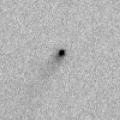
|
Now it is 15.6 mag (July 16, Ken-ichi Kadota). It stays 15 mag from summer to autumn. In the Northern Hemisphere, it stays observable in good condition for a long time. In the Southern Hemisphere, it will be getting lower gradually after this.
Date(TT) R.A. (2000) Decl. Delta r Elong. m1 Best Time(A, h)
Aug. 28 5 44.30 23 18.1 1.586 1.532 68 15.3 4:00 (271, 45)
Sept. 4 6 4.73 24 51.7 1.550 1.538 70 15.3 4:07 (271, 49)
|
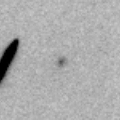
|
Now it is 15.5 mag (July 27, Ken-ichi Kadota). It will brighten rapidly up to 15 mag in autumn. It will be observable in excellent condition in the Northern Hemisphere. It locates somewhat low in the Southern Hemisphere.
Date(TT) R.A. (2000) Decl. Delta r Elong. m1 Best Time(A, h)
Aug. 28 4 52.96 19 40.3 1.503 1.665 80 15.4 4:00 (285, 54)
Sept. 4 5 10.54 20 53.3 1.450 1.661 82 15.3 4:07 (287, 58)
|
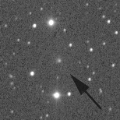
|
It brightened up to 14.2 mag in early summer (June 10, Thomas Lehmann). Now it is not observable. It will be fading after this. In the Northern Hemisphere, it will appear in the morning sky at 16 mag in October. In the Southern Hemisphere, it will never be observable again.
Date(TT) R.A. (2000) Decl. Delta r Elong. m1 Best Time(A, h)
Aug. 28 10 52.95 19 36.5 3.017 2.039 11 15.5 20:00 (119, -7)
Sept. 4 11 7.36 20 32.8 3.028 2.063 13 15.6 19:49 (120, -6)
|
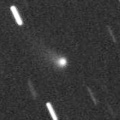
|
Now it is 15.7 mag (Aug. 11, Thomas Lehmann). In the Northern Hemisphere, it stays observable at 15-16 mag for a long time from spring to early 2022. In the Southern Hemisphere, it is not observable until the end of 2021.
Date(TT) R.A. (2000) Decl. Delta r Elong. m1 Best Time(A, h)
Aug. 28 12 34.38 40 10.0 3.685 3.005 41 15.5 20:00 (124, 23)
Sept. 4 12 38.01 37 47.5 3.726 3.008 38 15.5 19:49 (123, 19)
|

|
Now it is 15.8 mag (Aug. 10, Thomas Lehmann). It will brighten up to 13 mag in 2022. In 2021, it is observable at 14-15 mag in good condition.
Date(TT) R.A. (2000) Decl. Delta r Elong. m1 Best Time(A, h)
Aug. 28 13 45.84 -8 29.3 3.901 3.391 53 15.5 20:00 ( 71, 11)
Sept. 4 13 53.34 -9 23.4 3.963 3.377 48 15.5 19:49 ( 72, 8)
|
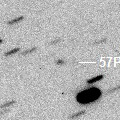
|
Now it is 16.7 mag (July 17, Ken-ichi Kadota). It will brighten up to 15.5 mag from summer to autumn. It stays observable for a long time.
Date(TT) R.A. (2000) Decl. Delta r Elong. m1 Best Time(A, h)
Aug. 28 16 7.01 -17 26.6 1.495 1.782 88 15.6 20:00 ( 38, 28)
Sept. 4 16 20.83 -18 10.1 1.539 1.766 85 15.6 19:49 ( 38, 27)
|

|
Now it is 16.3 mag (July 25, J. L. Virlichie, P. Traverse, H. Roy, J. P. Desgrees). It is expected to brighten up to 13 mag in 2022. In the Southern Hemisphere, it stays observable in good condition for a long time, although it becomes extremely low temporarily from September to October. In the Northern Hemisphere, it is not observable for a while.
Date(TT) R.A. (2000) Decl. Delta r Elong. m1 Best Time(A, h)
Aug. 28 12 7.02 -24 23.5 4.875 4.182 42 15.7 20:00 ( 72,-18)
Sept. 4 12 9.53 -25 12.4 4.893 4.141 37 15.6 19:49 ( 73,-21)
|
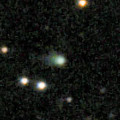
|
Now it is 16.3 mag (Aug. 11, Thomas Lehmann). It is expected to brighten up to 11 mag in 2023. In the Northern Hemisphere, it stays observable in good condition for a long time. It locates extremely low in the Southern Hemisphere.
Date(TT) R.A. (2000) Decl. Delta r Elong. m1 Best Time(A, h)
Aug. 28 16 10.49 43 1.2 6.209 6.124 80 15.8 20:00 (117, 62)
Sept. 4 16 8.14 41 51.5 6.225 6.080 77 15.7 19:49 (114, 59)
|
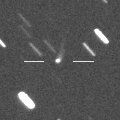
|
It will brighten up to 14.5 mag from spring to summer. In the Southern Hemisphere, it stays observable in excellent condition for a long time. In the Northern Hemisphere, it is not observable after this.
Date(TT) R.A. (2000) Decl. Delta r Elong. m1 Best Time(A, h)
Aug. 28 10 27.32 -54 57.1 3.250 2.964 64 15.8 20:00 ( 44,-45)
Sept. 4 10 40.35 -53 59.7 3.347 2.997 61 15.9 4:07 (314,-42)
|
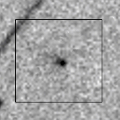
|
Now it is not observable. In the Southern Hemisphere, it will appear in the morning sky at 11 mag in late January, then it stays observable at 11 mag until June. In the Northern Hemisphere, it will appear in the morning sky in December, but it stays locating extremely low for a long time.
Date(TT) R.A. (2000) Decl. Delta r Elong. m1 Best Time(A, h)
Aug. 28 12 11.15 2 25.3 3.290 2.435 27 16.0 20:00 ( 94, -2)
Sept. 4 12 22.46 1 10.6 3.283 2.393 23 15.8 19:49 ( 94, -4)
|
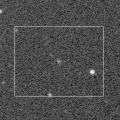
|
Now it is 16.4 mag (Aug. 20, Thomas Lehmann). It will brighten up to 12.5 mag in 2022 summer. In the Southern Hemisphere, it stays observable in excellent condition for a long time. In the Northern Hemisphere, it is not observable until August in 2022.
Date(TT) R.A. (2000) Decl. Delta r Elong. m1 Best Time(A, h)
Aug. 28 4 0.03 -61 14.1 4.391 4.701 101 15.9 4:00 (349, -8)
Sept. 4 3 56.48 -63 32.2 4.328 4.654 102 15.9 4:07 (354, -9)
|
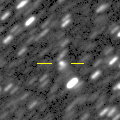
|
Now it is 15.7 mag (July 17, Toshiyuki Takahashi). It stays observable at 15-16 mag in good condition until autumn.
Date(TT) R.A. (2000) Decl. Delta r Elong. m1 Best Time(A, h)
Aug. 28 16 30.85 -11 41.9 4.701 4.862 93 15.9 20:00 ( 36, 36)
Sept. 4 16 32.36 -11 6.8 4.814 4.862 86 15.9 19:49 ( 40, 34)
|

|
It brightened up to 11.6 mag in winter (Feb. 18, Thomas Lehmann). Now it is fading. It has already faded down to 15.4 mag (Aug. 20, Thomas Lehmann). In the Southern Hemisphere, it stays observable in good condition after this. In the Northern Hemisphere, it will never be observable after this.
Date(TT) R.A. (2000) Decl. Delta r Elong. m1 Best Time(A, h)
Aug. 28 5 25.89 -62 20.5 3.468 3.644 91 15.9 4:00 (340,-14)
Sept. 4 5 19.37 -63 54.4 3.509 3.709 93 16.0 4:07 (345,-13)
|
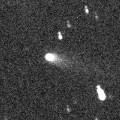
|
Now it is 15.4 mag (Aug. 12, Michael Jager). It stays observable at 16 mag in good condition until autumn.
Date(TT) R.A. (2000) Decl. Delta r Elong. m1 Best Time(A, h)
Aug. 28 23 19.02 -11 6.6 1.303 2.298 166 16.0 0:55 ( 0, 44)
Sept. 4 23 15.91 -12 21.7 1.293 2.296 172 16.0 0:25 ( 0, 43)
|

|
Now it is 19.4 mag (Aug. 12, Thomas Lehmann). It will brightens rapidly. And it is expected to be observable at 10-11 mag in good condition from December to February.
Date(TT) R.A. (2000) Decl. Delta r Elong. m1 Best Time(A, h)
Aug. 28 22 30.07 0 20.0 0.960 1.963 169 16.6 0:07 ( 0, 55)
Sept. 4 22 21.89 -0 31.6 0.902 1.903 170 16.2 23:26 ( 0, 54)
|
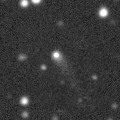
|
Now it is 16.0 mag (July 18, Ken-ichi Kadota). It stays observable at 16 mag from 2021 to 2022.
Date(TT) R.A. (2000) Decl. Delta r Elong. m1 Best Time(A, h)
Aug. 28 13 57.96 2 43.0 5.247 4.711 53 16.2 20:00 ( 79, 20)
Sept. 4 14 2.46 2 56.2 5.326 4.708 47 16.2 19:49 ( 81, 18)
|
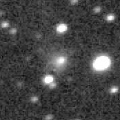
|
Now it is 16.0 mag (July 23, ATLAS-MLO, Mauna Loa). It is observable at 16 mag from 2020 to 2021. It locates low in the Southern Hemisphere.
Date(TT) R.A. (2000) Decl. Delta r Elong. m1 Best Time(A, h)
Aug. 28 22 17.11 41 53.8 5.400 6.077 128 16.3 23:49 (180, 83)
Sept. 4 22 9.85 40 47.1 5.378 6.088 130 16.3 23:14 (180, 84)
|
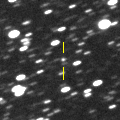
|
Now it is 16.1 mag (Aug. 2, F. Kugel, J.-G. Bosch). It is expected to brighten up to 11 mag from spring to summer in 2022. In the Southen Hemisphere, it locates somewhat low in 2021, but it will be observable in good condition at the high light for a long time. In the Northern Hemisphere, it is observable in good condition in 2021, but it will not be observable at the high light.
Date(TT) R.A. (2000) Decl. Delta r Elong. m1 Best Time(A, h)
Aug. 28 19 1.97 28 3.5 3.235 3.813 117 16.4 20:34 ( 0, 83)
Sept. 4 18 54.59 25 43.7 3.228 3.749 113 16.3 19:59 ( 0, 81)
|
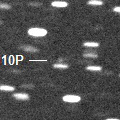
|
Now it is 18.0 mag (Aug. 1, Palomar Mountain--ZTF). It will brightens rapidly. And it will be observable at 15 mag in excellent condition in winter.
Date(TT) R.A. (2000) Decl. Delta r Elong. m1 Best Time(A, h)
Aug. 28 6 45.00 27 37.2 2.917 2.476 54 16.5 4:00 (258, 35)
Sept. 4 6 58.00 27 9.2 2.842 2.471 58 16.4 4:07 (261, 39)
|

|
Now it is 16.0 mag (July 20, Thomas Lehmann). In the Northern Hemisphere, it stays observable for a long time while it is getting fainter slowly. In the Southern Hemisphere, it will never be observable again.
Date(TT) R.A. (2000) Decl. Delta r Elong. m1 Best Time(A, h)
Aug. 28 13 42.59 48 59.4 7.100 6.597 56 16.4 20:00 (128, 37)
Sept. 4 13 46.12 47 54.9 7.174 6.645 54 16.4 19:49 (128, 35)
|
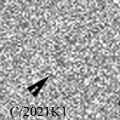
|
Now it is 15.1 mag (Aug. 18, Ken-ichi Kadota). It will be fading after this, and it will be fainter than 18 mag in November.
Date(TT) R.A. (2000) Decl. Delta r Elong. m1 Best Time(A, h)
Aug. 28 1 16.36 -8 25.0 1.900 2.735 137 16.5 2:52 ( 0, 47)
Sept. 4 1 16.27 -9 26.3 1.882 2.763 144 16.6 2:25 ( 0, 46)
|
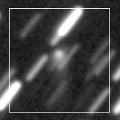
|
Now it is 16.4 mag (Aug. 2, ATLAS-HKO, Haleakala). It stays at 16-17 mag from 2020 to 2021. In the Northern Hemisphere, it stays observable in good condition for a long time. It locates extremely low in the Southern Hemisphere.
Date(TT) R.A. (2000) Decl. Delta r Elong. m1 Best Time(A, h)
Aug. 28 18 29.76 51 1.5 8.632 8.876 100 16.5 20:02 (180, 74)
Sept. 4 18 26.51 50 41.5 8.668 8.881 98 16.6 19:49 (170, 74)
|
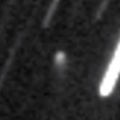
|
Now it is 17.1 mag (Aug. 2, ATLAS-HKO, Haleakala). It will brighten up to 15.5 mag in winter. In the Northern Hemisphere, it stays observable in good condition for a long time. It is not observable at all in the Southern Hemisphere.
Date(TT) R.A. (2000) Decl. Delta r Elong. m1 Best Time(A, h)
Aug. 28 16 22.22 71 39.2 3.363 3.346 80 16.6 20:00 (165, 50)
Sept. 4 16 6.32 70 21.3 3.349 3.315 79 16.5 19:49 (161, 49)
|
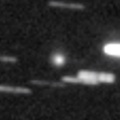
|
Now it is 16.8 mag (July 18, Toshihiko Ikemura, Hirohisa Sato). It is expected to brighten up to 11 mag in 2023. In the Northern Hemisphere, it is observable in good condition in 2021. But it is observable only until November in 2022. In the Southern Hemisphere, it locates extremely low in 2021. But it will be observable in good condition at the high light.
Date(TT) R.A. (2000) Decl. Delta r Elong. m1 Best Time(A, h)
Aug. 28 17 27.61 37 34.7 6.159 6.344 95 16.6 20:00 (106, 78)
Sept. 4 17 26.28 36 14.2 6.168 6.296 92 16.5 19:49 (100, 74)
|

|
It stays observable at 16 mag from autumn to winter. In the Northern Hemisphere, it stays observable in good condition. In the Southern Hemisphere, it stays extremely low until November.
Date(TT) R.A. (2000) Decl. Delta r Elong. m1 Best Time(A, h)
Aug. 28 8 3.20 26 57.1 2.504 1.814 37 16.6 4:00 (250, 19)
Sept. 4 8 23.06 25 47.1 2.456 1.802 39 16.6 4:07 (253, 21)
|
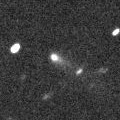
|
Now it is 16.6 mag (Aug. 18, Ken-ichi Kadota). It stays observable at 16.5 mag in good condition until October.
Date(TT) R.A. (2000) Decl. Delta r Elong. m1 Best Time(A, h)
Aug. 28 23 26.53 -0 15.8 1.184 2.168 162 16.6 1:03 ( 0, 55)
Sept. 4 23 21.18 0 8.9 1.170 2.169 169 16.6 0:30 ( 0, 55)
|
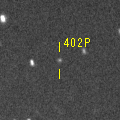
|
First return of a new periodic comet observed at 16 mag from 2003 to 2004. Now it is 16.8 mag (Apr. 11, J. Drummond). It will brighten up to 16 mag in winter, and it will be observable in excellent condition.
Date(TT) R.A. (2000) Decl. Delta r Elong. m1 Best Time(A, h)
Aug. 28 6 7.57 2 17.2 4.315 3.987 64 16.7 4:00 (289, 29)
Sept. 4 6 13.59 2 9.8 4.223 3.981 69 16.6 4:07 (295, 34)
|
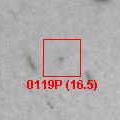
|
Now it is 18.9 mag (Aug. 3, ATLAS-HKO, Haleakala). It will brighten up to 14.5 mag in 2022 winter. In 2021, it stays observable in good condition while the comet will be brightening gradually. It is fainter than this ephemeris recently.
Date(TT) R.A. (2000) Decl. Delta r Elong. m1 Best Time(A, h)
Aug. 28 22 50.94 -16 32.1 2.222 3.223 170 16.9 0:27 ( 0, 39)
Sept. 4 22 45.98 -17 11.7 2.199 3.197 170 16.8 23:50 ( 0, 38)
|
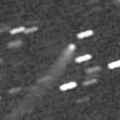
|
Now it is 16.5 mag (July 29, ATLAS-HKO, Haleakala). Fading slowly. In the Northern Hemisphere, it stays observable in good condition for a long time. It is not observable after this in the Southern Hemisphere.
Date(TT) R.A. (2000) Decl. Delta r Elong. m1 Best Time(A, h)
Aug. 28 16 19.13 53 24.1 5.733 5.666 81 16.8 20:00 (139, 61)
Sept. 4 16 16.29 52 34.5 5.806 5.699 78 16.9 19:49 (135, 59)
|
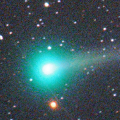
|
It brightened up to 3 mag in December in the SOHO spacecraft images (Dec. 18, Hirohisa Sato). Now it is 16.2 mag (July 22, ATLAS-MLO, Mauna Loa). It stays observable in good condition after this while the comet will be fading.
Date(TT) R.A. (2000) Decl. Delta r Elong. m1 Best Time(A, h)
Aug. 28 23 52.39 19 0.2 3.229 4.091 144 16.9 1:29 ( 0, 74)
Sept. 4 23 46.12 18 23.9 3.259 4.170 150 17.0 0:55 ( 0, 74)
|
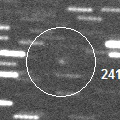
|
Now it is 17.3 mag (Aug. 2, F. Kugel, J.-G. Bosch). In the Northern Hemisphere, it stays observable at 17 mag in good condition until winter. In the Southern Hemisphere, it stays locating extremely low for a while.
Date(TT) R.A. (2000) Decl. Delta r Elong. m1 Best Time(A, h)
Aug. 28 6 50.72 36 52.7 2.331 1.944 55 17.2 4:00 (247, 37)
Sept. 4 7 9.23 36 11.3 2.292 1.956 58 17.2 4:07 (249, 40)
|
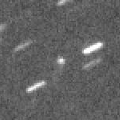
|
It will brighten up to 16 mag in 2022. In the Northern Hemisphere, it stays observable in good condition for a long time. In the Southern Hemisphere, it is not observable until 2023.
Date(TT) R.A. (2000) Decl. Delta r Elong. m1 Best Time(A, h)
Aug. 28 8 8.56 49 19.3 4.916 4.317 48 17.3 4:00 (228, 28)
Sept. 4 8 16.74 50 22.9 4.807 4.288 53 17.2 4:07 (228, 32)
|
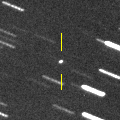
|
Now it is 17.1 mag (Aug. 18, Toshiyuki Takahashi). In the Northern Hemisphere, it stays observable in good condition after this while the comet will be fading. In the Southern Hemisphere, it stays locating extremely low for a long time.
Date(TT) R.A. (2000) Decl. Delta r Elong. m1 Best Time(A, h)
Aug. 28 4 59.74 35 55.9 2.492 2.477 77 17.3 4:00 (257, 59)
Sept. 4 5 7.65 36 44.7 2.460 2.532 82 17.3 4:07 (257, 64)
|
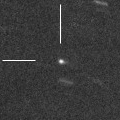
|
Now it is 17.5 mag (Aug. 12, Michael Jager). It is observable at 17 mag in good condition in autumn.
Date(TT) R.A. (2000) Decl. Delta r Elong. m1 Best Time(A, h)
Aug. 28 2 29.81 18 51.6 3.320 3.835 113 17.4 4:00 (356, 74)
Sept. 4 2 31.19 18 46.7 3.227 3.831 119 17.4 3:39 ( 0, 74)
|
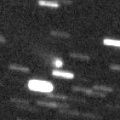
|
Now it is 16.6 mag (July 25, ATLAS-MLO, Mauna Loa). It will be fading after this, and it will be fainter than 18 mag in October.
Date(TT) R.A. (2000) Decl. Delta r Elong. m1 Best Time(A, h)
Aug. 28 15 9.60 -22 37.0 5.332 5.192 76 17.4 20:00 ( 47, 16)
Sept. 4 15 8.90 -23 3.8 5.478 5.217 69 17.5 19:49 ( 49, 13)
|

|
It had been observed as 8-9 mag for a long time in 2020. Now it is fading. It has already faded down to 17.6 mag (July 29, J. Drummond). It will be observable in good condition after this in the Southern Hemisphere. It locates extremely low after this in the Northern Hemisphere.
Date(TT) R.A. (2000) Decl. Delta r Elong. m1 Best Time(A, h)
Aug. 28 16 8.96 -45 19.1 5.410 5.572 94 17.4 20:00 ( 23, 4)
Sept. 4 16 10.88 -45 13.4 5.575 5.633 88 17.6 19:49 ( 26, 3)
|

|
Now it is 17.7 mag (May 12, ATLAS-HKO, Haleakala). It brightened rapidly. It stays 17-18 mag for a long time from 2021 to 2022. In the Southern Hemisphere, it stays observable in good condition for a long time. In the Northern Hemisphere, it will be observable only in extremely low sky from autumn to winter.
Date(TT) R.A. (2000) Decl. Delta r Elong. m1 Best Time(A, h)
Aug. 28 8 53.78 -17 21.3 6.154 5.363 35 17.5 4:00 (281,-16)
Sept. 4 8 56.72 -18 30.0 6.113 5.358 38 17.5 4:07 (286,-10)
|
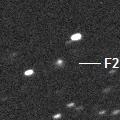
|
Now it is 17.8 mag (Aug. 4, ATLAS-HKO, Haleakala). It stays observable at 17-18 mag for a long time until 2024.
Date(TT) R.A. (2000) Decl. Delta r Elong. m1 Best Time(A, h)
Aug. 28 14 18.90 -5 20.3 9.476 9.013 59 17.5 20:00 ( 69, 19)
Sept. 4 14 19.17 -5 22.1 9.570 9.004 53 17.5 19:49 ( 71, 16)
|
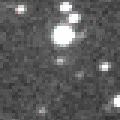
|
Now it is 17.0 mag (July 26, ATLAS-HKO, Haleakala)�$B!#�(BIt stays observable at 17-18 mag for a long time from 2021 to 2022.
Date(TT) R.A. (2000) Decl. Delta r Elong. m1 Best Time(A, h)
Aug. 28 19 4.63 -18 47.3 3.388 4.117 130 17.5 20:38 ( 0, 36)
Sept. 4 19 4.38 -18 52.0 3.464 4.111 123 17.5 20:10 ( 0, 36)
|
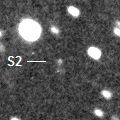
|
First return of a new periodic comet which brightened up to 17 mag in 2012. Now it is 18.3 mag (July 10, ATLAS-HKO, Haleakala). In the Southern Hemisphere, it is observable at 17.5 mag in excellent condition in summer. It locates low in the Northern Hemisphere.
Date(TT) R.A. (2000) Decl. Delta r Elong. m1 Best Time(A, h)
Aug. 28 19 32.19 -41 22.3 0.712 1.569 130 17.5 21:06 ( 0, 14)
Sept. 4 19 34.70 -40 55.2 0.709 1.530 124 17.6 20:41 ( 0, 14)
|
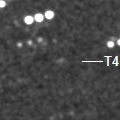
|
Now it is extremely faint as 20.5 mag (June 17, M. Jaeger, E. Prosperi, S. Prosperi). It was predicted to brighten up to 17.5 mag in 2021 summer. But actually, it is much fainter than predicted. It is not observable in the Southern Hemisphere.
Date(TT) R.A. (2000) Decl. Delta r Elong. m1 Best Time(A, h)
Aug. 28 13 43.90 53 39.2 2.630 2.278 58 17.7 20:00 (134, 38)
Sept. 4 13 58.69 49 25.4 2.681 2.302 57 17.8 19:49 (129, 37)
|
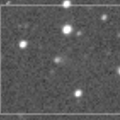
|
First return of a new periodic comet which brightened up to 17 mag in 2006. Now it is 17.4 mag (June 15, Taras Prystavski). It stays 18 mag from 2021 to 2022.
Date(TT) R.A. (2000) Decl. Delta r Elong. m1 Best Time(A, h)
Aug. 28 21 58.35 -69 13.2 2.619 3.250 120 17.7 23:31 ( 0,-14)
Sept. 4 21 48.81 -68 32.4 2.639 3.236 117 17.7 22:54 ( 0,-13)
|

|
It brightened up to 18.5 mag in 2020 spring (Apr. 2, 2020, W. Hasubick). Now it is 19.3 mag (July 16, J. P. Desgrees, J. L. Virlichie, P. Traverse, H. Roy). It has passed the perihelion in 2020 October. At the discovery in 2005, it stayed bright for several years even after the perihelion passage. In this apparition, it may stay observable at 18 mag from 2021 to 2024.
Date(TT) R.A. (2000) Decl. Delta r Elong. m1 Best Time(A, h)
Aug. 28 23 41.88 -27 47.5 2.961 3.898 154 17.7 1:18 ( 0, 27)
Sept. 4 23 38.21 -28 23.3 2.975 3.919 156 17.7 0:47 ( 0, 27)
|

|
It stays 17 mag for a long time from 2021 to 2022. It is observable in excellent condition in the Northern Hemisphere, It locates somewhat low in the Southern Hemisphere.
Date(TT) R.A. (2000) Decl. Delta r Elong. m1 Best Time(A, h)
Aug. 28 5 38.51 32 4.9 5.876 5.603 69 17.8 4:00 (260, 50)
Sept. 4 5 36.97 32 22.3 5.737 5.588 76 17.7 4:07 (263, 57)
|

|
Appearing in the morning sky. It will brighten up to 15.5 mag, and will be observable in excellent condition in winter.
Date(TT) R.A. (2000) Decl. Delta r Elong. m1 Best Time(A, h)
Aug. 28 7 36.92 19 22.3 2.722 2.082 41 17.9 4:00 (260, 21)
Sept. 4 7 53.33 18 52.1 2.659 2.068 44 17.7 4:07 (263, 24)
|

|
Now it is 16.4 mag (July 31, ATLAS-HKO, Haleakala). It will be fading slowly.
Date(TT) R.A. (2000) Decl. Delta r Elong. m1 Best Time(A, h)
Aug. 28 16 55.24 -10 53.8 7.768 7.988 98 17.8 20:00 ( 30, 39)
Sept. 4 16 53.76 -10 48.5 7.917 8.015 91 17.8 19:49 ( 35, 37)
|
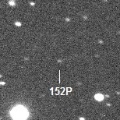
|
Now it is 17.7 mag (July 13, ATLAS-MLO, Mauna Loa). It will brighten up to 16 mag in 2022. In 2021, it stays observable at 18 mag until September.
Date(TT) R.A. (2000) Decl. Delta r Elong. m1 Best Time(A, h)
Aug. 28 14 9.12 -6 35.2 3.603 3.184 57 17.8 20:00 ( 69, 16)
Sept. 4 14 17.12 -7 35.2 3.672 3.175 53 17.8 19:49 ( 70, 14)
|

|
Now it is 18.6 mag (Aug. 3, ATLAS-HKO, Haleakala). It will brighten up to 16.5-17 mag in winter. In its last apparition in 2015, it brightened up to 13 mag.
Date(TT) R.A. (2000) Decl. Delta r Elong. m1 Best Time(A, h)
Aug. 28 22 11.98 -29 50.0 1.472 2.444 159 17.9 23:44 ( 0, 25)
Sept. 4 22 5.39 -30 56.8 1.455 2.402 154 17.8 23:10 ( 0, 24)
|
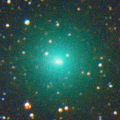
|
It brightened up to 8.2 mag in 2020 autumn (Oct. 13, 2020, Chris Wyatt). Now it is 18.9 mag (July 15, Palomar Mountain--ZTF). It is observable at 18 mag in 2021.
Date(TT) R.A. (2000) Decl. Delta r Elong. m1 Best Time(A, h)
Aug. 28 5 4.08 23 0.1 3.251 3.188 77 17.8 4:00 (278, 53)
Sept. 4 5 8.57 23 10.8 3.185 3.225 83 17.9 4:07 (284, 59)
|
|
![]()
 C/2020 H6 ( ATLAS )
C/2020 H6 ( ATLAS ) C/2019 T3 ( ATLAS )
C/2019 T3 ( ATLAS ) C/2021 E3 ( ZTF )
C/2021 E3 ( ZTF ) 110P/Hartley 3
110P/Hartley 3 C/2018 N2 ( ASASSN )
C/2018 N2 ( ASASSN ) C/2021 K1 ( ATLAS )
C/2021 K1 ( ATLAS ) C/2019 O3 ( Palomar )
C/2019 O3 ( Palomar ) C/2021 D2 ( ZTF )
C/2021 D2 ( ZTF ) C/2020 K1 ( PanSTARRS )
C/2020 K1 ( PanSTARRS ) 52P/Harrington-Abell
52P/Harrington-Abell 193P/LINEAR-NEAT
193P/LINEAR-NEAT 402P/2020 Q3 ( LINEAR )
402P/2020 Q3 ( LINEAR ) 119P/Parker-Hartley
119P/Parker-Hartley C/2019 K7 ( Smith )
C/2019 K7 ( Smith ) C/2020 S3 ( Erasmus )
C/2020 S3 ( Erasmus ) 241P/LINEAR
241P/LINEAR C/2020 U5 ( PanSTARRS )
C/2020 U5 ( PanSTARRS ) 28P/Neujmin 1
28P/Neujmin 1 P/2021 N2 ( Fuls )
P/2021 N2 ( Fuls ) C/2017 Y2 ( PanSTARRS )
C/2017 Y2 ( PanSTARRS ) C/2017 T2 ( PanSTARRS )
C/2017 T2 ( PanSTARRS ) C/2020 F7 ( Lemmon )
C/2020 F7 ( Lemmon ) C/2020 F2 ( ATLAS )
C/2020 F2 ( ATLAS ) 395P/2020 H1 ( Catalina-NEAT )
395P/2020 H1 ( Catalina-NEAT ) 424P/2021 L5 ( La Sagra )
424P/2021 L5 ( La Sagra ) C/2020 T4 ( PanSTARRS )
C/2020 T4 ( PanSTARRS ) 422P/2021 L1 ( Christensen )
422P/2021 L1 ( Christensen ) 378P/2019 E2 ( McNaught )
378P/2019 E2 ( McNaught ) C/2020 U4 ( PanSTARRS )
C/2020 U4 ( PanSTARRS ) 70P/Kojima
70P/Kojima C/2017 U7 ( PanSTARRS )
C/2017 U7 ( PanSTARRS ) 152P/Helin-Lawrence
152P/Helin-Lawrence 230P/LINEAR
230P/LINEAR 88P/Howell
88P/Howell![]()



































































